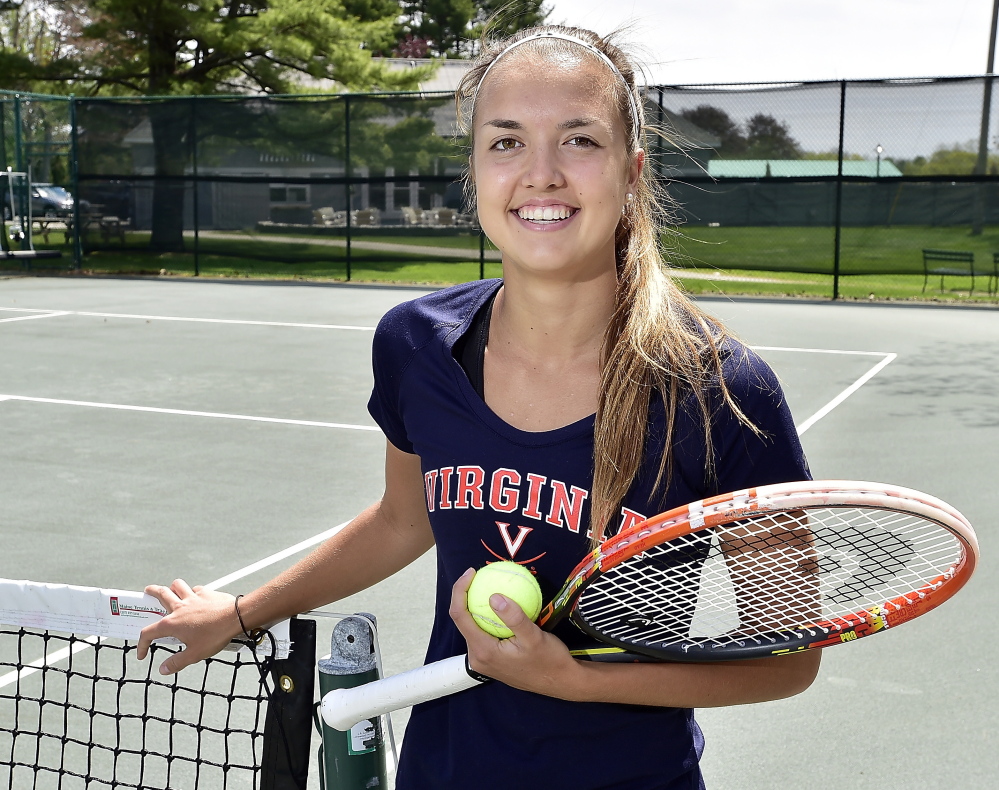FALMOUTH — The state’s top 48 high school tennis players will compete in the Maine Principals’ Association singles tournament Friday and Saturday at Colby College, with the semifinals and finals scheduled for Monday at Bates College.
Defending girls’ champion Olivia Leavitt, a Falmouth senior, will be there as the top seed. Rosemary Campanella, a Wells freshman whose high school doesn’t offer tennis, is seeded third.
No matter who emerges as finalists, however, they can’t truly claim to be Maine’s two best female high school tennis players.
That distinction belongs to Meghan Kelley of Falmouth and Mercedes “Sadie” Hammond of Belgrade, both of whom have accepted full athletic scholarships to compete at Division I universities. Hammond plans to enroll at Tennessee this fall and Kelley at Virginia in the fall of 2016.
Both Kelley and Hammond have sisters who play high school tennis. Kate Kelley is a Falmouth sophomore who recently teamed with classmate Amanda Watson to win the Western Maine Conference doubles title. Bethany Hammond is a sophomore at St. Dominic in Auburn and the second seed in the state singles tournament.
While Kate and Bethany followed a traditional school path, their older sisters have traveled the world for tournaments, trained out of state (Massachusetts for Meghan and Florida for Sadie), and taken online classes to prioritize tennis.
“You have to teach yourself quite a bit,” said Meghan Kelley, who remained in the Falmouth school system until eighth grade. She was home-schooled until enrolling in the Maine Connections Academy, the state’s first virtual charter school, which opened in September. “You have to be independent and diligent about getting your (academic) work done.”
Kelley and Hammond varied widely in their tennis journeys, but each bypassed in-state high school competition in favor of more rigorous training elsewhere.
“I haven’t seen her in a long time, probably more than a year and a half,” said Kelley of Hammond. “We used to play New England tournaments when we were really little. I was probably around 10 when we first met.”
Kelley, 17, has an October birthday and will continue to compete through December on the International Tennis Federation junior circuit. Her current world ranking – which incorporates both singles and doubles – is 156 after peaking at 148 in March.
Since last summer, Kelley has played tournaments in Uruguay, Mexico, Costa Rica, Colombia, Ecuador, Peru and Brazil, as well as Florida, California and Oklahoma. Next month she heads to Europe for the first time, with tournaments planned in Germany and England. Her goal is to make it into a Junior Grand Slam; currently she is an alternate for Wimbledon’s junior qualifying draw.
“That would be very cool,” she said of playing on grass (something she’s done only a handful of times) at the All England Club.
At last year’s Wimbledon qualifying tournament, the lowest-rated entrant was ranked 156, which matches Kelley’s current standing. So she likely won’t know until the eve of the event whether or not she’s in. Eight qualifiers from an initial field of 32 will advance to the junior ladies main draw.
Kelley visited several colleges before settling on Virginia. The Cavaliers are ranked among the NCAA’s top 10 programs and have reached the NCAA Round of 16 for five straight years.
“I was looking for a school where the academics are really strong and they’ve been having great success on the tennis side,” Kelley said. “When I met the coach and met the team, everything just clicked.”
While Kelley worked her way up through the junior circuit, Hammond opted for the professional circuit. The thinking was if Hammond could rise to 300 on the International Tennis Federation ranking list, she would turn pro and embark upon a career. If not, she would opt for college.
“For the past year and a half I’ve been playing as an amateur,” said Hammond, whose singles ranking peaked at 1,212 (currently) and doubles at 1,132 (in late December).
The NCAA’s eligibility rules allow tennis players to accept up to $10,000 per year in prize money before enrolling in college.
Hammond has returned to Maine with her coach after operating from Gainesville, Florida, for much of a past year that included tournaments in Mexico, Colombia, Italy and Canada in addition to the U.S. She plans to squeeze college orientation at Tennessee between tournaments in South Carolina and Canada.
A month ago Hammond won a wild-card tournament in Florida that gained her entrance to the main draw of a $50,000 event in Indian Harbour Beach, where she lost in the first round to Storm Sanders, a 20-year-old Australian with a World Tennis Association title under her belt. There have been a lot of losses on the pro circuit.
“But I’ve gained so much experience,” Hammond said. “Playing against the best players in the world, that’s helped me tremendously. It was frustrating for sure … but my coach (Reggie Hodges) helped me through it. We focused on my development and not so much the results.”
Hammond completed her high school coursework through a distance-learning school based in California called Laurel Springs. Because Tennessee competes in the Southeastern Conference, she and Kelley aren’t likely to cross paths in college, but through their sisters each knows what they’ve missed by choosing the solo route to Division I tennis.
“I do not have any regrets,” Hammond said. “For my game to grow and develop as it has, I needed to skip high school tennis.”
“I didn’t really contemplate the possibility of turning pro and not attending college,” Kelley said. “My ultimate goal was to get into a great school and hopefully, if I have a good college career, maybe pursue a professional career afterwards.”
Send questions/comments to the editors.




